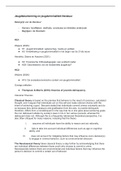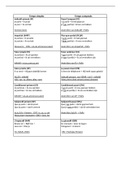Jeugdbescherming en jeugdcriminaliteit literatuur
Belangrijk van de literatuur:
- Kennen: hoofdlijnen: methode, conclusies en limitaties onderzoek
- Begrijpen: de theorieën
HC1:
Weijers (2020):
● H1: Jeugdcriminaliteit: wetenschap, media en politiek
● H3: Ontwikkeling in jeugdcriminaliteit in het begin van de 21ste eeuw
Hendriks, Stams en Asscher (2021):
● H2: Forensische Orthopedagogiek: een juridisch kader
● H29: Geschiedenis van de residentiële jeugdhulp?
HC2:
Weijers (2020):
● H15: De sociaaleconomische context van jeugdcriminaliteit
Overige artikelen:
● Thompson & Morris (2016): theories of juvenile delinquency
Classical Theories
Classical theory is based on the premise that behavior is the result of conscious, calculated
thought, and it argues that individuals act on free will and make rational choices with the
intent of achieving a goal. Beccaria stated that individuals commit crimes voluntarily and do
so because they derive pleasure and gratification from the acts. A juvenile delinquent,
therefore, differs from a nondelinquent in the way that he or she goes about achieving goals:
the non delinquent abides by society’s laws in his or her various pursuits, whereas the
delinquent does not. Although this is a frequently referenced theoretical perspective, it is
also often critiqued for many reasons, including that the theory
I. assumes all individuals have the ability to reason and act rationally,
II. fails to take into account individual differences such as age or cognitive
ability, and
III. does not account for mitigating factors that may influence one’s decision(s)
to engage in criminal behavior, such as environmental stressors
The Neoclassical theory takes classical theory a step further by acknowledging that there
are individual differences between those youth who choose to commit a crime.
Neoclassicists believe there are environmental and individual factors that may influence the
person’s decision to commit a certain act of behavior.
,The Rational Choice theory takes the position that individuals commit crimes using
reasoning and rational approaches to their behavior. It also allows for mitigating factors that
may influence and individual’s choice to commit a crime. Rational choice theory continues
the classical thought that a crime is com-mitted out of self-interest, but it argues that the
decision to commit a criminal act is reasoned out and based on a “rational choice”. The
primary criticism of this theory, however, is that it assumes that the individual has the ability
to make a reasoned, calculated decision.
Classical theories assume that abstract thinking and behavioral regulation are inherent in an
individual. While many individuals do have these abilities, the expectation that higher-level
thinking, reasoning, and self-regulation are inherent in youth directly conflicts with current
findings in cognitive neuroscience. This, therefore, calls into question some of the
assumptions upon which classical theories were formulated, namely, that an illegal act is
conducted only after a calculated decision has been made. Think for example about
juveniles dealing with ADHD (impulsivity), bipolar disorder and intellectual disabilities (lack of
intellectual capacity).
Psychological theories:
Psychological theories assume that while environmental factors may influence an individual,
the cause of juvenile delinquency is internal to the youth and, therefore, the individual is
directly responsible for his or her behavior and actions. This theoretical approach also
assumes that the psychological disturbance in the youth began in early childhood. Types of
psychological theories include psycho- analytic and psychodynamic theories, as well as
personality trait theory, social learning theory, and labeling theory.
Psychoanalytic and psychodynamic theories assume that individuals develop in stages,
at which point abnormalities may occur and, consequently, the development of their
personality is hindered. This, in turn, leads to conflicts between an individual’s personal
desires and restraints placed on him or her by society, which may lead to delinquent
behaviors. Psychodynamic theory assumes that delinquency is a manifestation of underlying
constructs comprising a person’s psychological framework, including Freud’s
conceptualizations of the “conscious” and “unconscious” and the interactions between the id,
ego, and super- ego. This theory, therefore, assumes that delinquency is the result of
psychic conflict between the mainly unconscious ego and conscious superego.
Personality trait theory assumes that traits develop primarily from childhood and are
internal mechanisms controlling the individual’s behavior. Most research supporting
personality trait theory describes general personality traits exhibited by juvenile delinquents.
Social learning theory is based on the work of Albert Bandura and maintains that
individuals learn to behave through their social interactions with others. As applied to
delinquent behavior, social learning theory suggests that individuals learn social behaviors
such as delinquent behavior through modeling. Criminal behavior will thus begin or continue
when it is seen in others with whom the delinquent strongly identifies or when the youth
observes that others are rewarded by engaging in the criminal behavior(s). Then she or he
develops positive attributions and beliefs regarding engaging in similar illegal acts
Labeling theory assumes that the initial delinquent act is caused by a number of factors,
with the primary reason for repeat offending being the label “delinquent” appended becomes
incorporated into the youth’s cognition of himself or herself. This theory argues that the label
alters the adolescent’s self-image so that she or he construes herself or himself as a
“delinquent” and, therefore, will act accordingly. Formal labels are those which social
agencies place on youth, and informal labels are those placed on youth by teachers,
parents, friends, or peers. In this regard, Becker argued that peer social groups may also
,impact the effect of labeling, because many serve as social support systems for the youth in
which their delinquent behaviors are accepted and supported.
These theories appear to assume that a youth has responsibility over the acts in which he or
she engages. More specifically, these psychological theories do not take into consideration
the increased presence of cognitive, developmental, educational, and/or mental health
disabilities that have been found in juvenile offenders, which can subsequently have a
negative effect on a juvenile’s ability to engage in rational thinking and related decision-
making. In addition, these theories do not account for the impact that a disability often has
on a youth’s social functioning which, in turn, may subsequently influence the youth’s
behavior choices and contribute to his or her negative social interactions.
Sociological Theories
Personal and situational influences may be taken into consideration with Sociological
theories, but ultimately, it is assumed that delinquency is caused primarily by social factors in
the environment
Social disorganization theory proposes that juvenile delinquency is the result of a
breakdown of institutional structures in the youth offender’s environment. This theory
hypothesizes that social disorganization in an area leads to a community’s inability to
maintain social order and exert informal social control. This disorganization, in turn, leads to
the development of criminal values and traditions which replace conventional values and
traditions, with the process then becoming a self-perpetuating revolving door. This theory
argues that the disorganization occurs more readily in urban areas because of rapid
industrialization and urbanization, and it is often used to understand social conditions
associated with crime rates. Shaw and McKay were the first to apply this theory to juvenile
delinquency. They studied delinquency rates in Chicago and found that in addition to juvenile
crime rates being substantially higher in the central city, areas with low rates of juvenile
delinquency were characterized by “uniformity, conformity, and universality of conventional
values and attitudes with respect to child care, conformity to laws, and related matters... “
Anomie theory is similar to social disorganization theory; however, a primary difference
between these two theories is that anomie generally refers to larger societal conditions, and
it refers mostly to the inconsistency between societal conditions and individual opportunities
for growth, fulfillment, and productivity within a society. Anomie theory’s primary assumption
in the etiology of juvenile delinquency is that youth who find themselves at an economic
disadvantage are more motivated to engage in delinquent behaviors. The theory argues that
if these individuals were allowed the same opportunities as others, they would not engage in
delinquent behaviors. When these youth are not allowed these same opportunities, they
become frustrated with society and engage in criminal activities or engage in crime acts out
of economic necessity. Merton suggested that criminal behavior results after one’s inability
to obtain his or her desired goal(s). More recently, this theory was expanded upon and is
now generally referred to as strain theory
Strain theory posits that it is strains or stressors in the individual’s environment that
increase the likelihood of criminal behavior occurring. The theory states that individuals try to
obtain certain goals as well as avoid painfull situations. The attempt at avoiding painful
situations may become frustrating for the individual and consequently produces strain.
Attempts to escape this strain may include criminal activities. Agnew described likely
situations under which criminal behavior would occur in response to strain, including the
strain;
I. being severe or high in magnitude,
, II. seen as unjust,
III. associated with low social control, and
IV. creating some pressure or incentive for violent or criminal behavior
Agnew noted in his theory that not all juveniles who experience strain become delinquents,
arguing that there are constraints, such as values, goals, self-esteem, intelligence,
interpersonal skills, social support, or societal values, which may support the individual.
Therefore, delinquency is less likely to occur if the costs of the delinquent acts exceed the
benefits.
In addition, while strain theory does not specifically mention the impact of disability on
juvenile delinquency, it does attempt to account to some extent for individual differences that
may impact a youth’s participation in delinquent behavior, such as intelligence, social skills,
or internalizing difficulties.
However, similar to the comments made regarding classical and psychological theories,
sociological theories do not appear to take into consideration more contemporary research
findings regarding the presence of poor impulse control, emotional dysregulation, or
cognitive immaturity common in many youth having a cognitive, developmental, educational,
or mental health disability.
Control theories
Control theories of criminal behavior assume that the motivation an individual has to commit
a crime is similar to the motivation for all other behaviors. Control theories assume that
behavior is motivated by the pursuit of pleasure and the avoidance of pain. Control theories,
therefore, seek to explain what drives the majority of society to refrain, in general, from
engaging in criminal behavior.
Social control theory was developed by Hirschi and argues that when an individual’s
relationships with family, friends, and society are broken, they are more likely to engage in
delinquent behavior. According to Hirschi, individuals abide by society’s rules and values
because they fear having bonds broken with other individuals in society. Once these are
broken, the individual has less motivation to abide by society’s laws and, consequently, is
more likely to engage in criminal behavior.
Self-control theory assumes that the basis for the development of conforming behavior is
the attachments that children form early in life with parents or other caregivers. This theory
argues that it is these early attachments and bonds that aid in the tendency of the child to
regulate his or her conduct by developing an ability to delay instant or near gratification and
avoid long-term negative consequences. Specifically, self-control theory is the ability to delay
short-term personal gain for long-term personal rewards and interests, and it focuses on
socialization as a primary means for an individual to develop self-control. Therefore, those
with lower levels of self-control are more likely to engage in delinquent behavior than those
with higher levels of self-control.
Control theories suggest that youth having less self-control are more likely to engage in
delinquent behavior. Control theories also appear to be able to explain why social difficulties
may be related to delinquency. Although control theories do not directly discuss the
interaction of disability and delinquency, they do provide researchers with a foundation for
further exploring hypotheses focusing on the relationship between juvenile delinquency and
disability.





